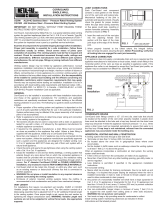Weil-McLain GV Owner's manual
- Category
- Water heaters & boilers
- Type
- Owner's manual
This manual is also suitable for
Weil-McLain GV is a series of gas boilers designed for residential and light commercial applications. It features a high-efficiency condensing design that can save you money on your energy bills. The GV is also a sealed combustion boiler, which means it does not require a chimney. Instead, it uses a vent system to exhaust combustion gases. The GV is available in a variety of sizes and configurations to meet your specific needs. It can be installed in a variety of locations, including closets, basements, and crawl spaces.
Weil-McLain GV is a series of gas boilers designed for residential and light commercial applications. It features a high-efficiency condensing design that can save you money on your energy bills. The GV is also a sealed combustion boiler, which means it does not require a chimney. Instead, it uses a vent system to exhaust combustion gases. The GV is available in a variety of sizes and configurations to meet your specific needs. It can be installed in a variety of locations, including closets, basements, and crawl spaces.








-
 1
1
-
 2
2
-
 3
3
-
 4
4
-
 5
5
-
 6
6
-
 7
7
-
 8
8
Weil-McLain GV Owner's manual
- Category
- Water heaters & boilers
- Type
- Owner's manual
- This manual is also suitable for
Weil-McLain GV is a series of gas boilers designed for residential and light commercial applications. It features a high-efficiency condensing design that can save you money on your energy bills. The GV is also a sealed combustion boiler, which means it does not require a chimney. Instead, it uses a vent system to exhaust combustion gases. The GV is available in a variety of sizes and configurations to meet your specific needs. It can be installed in a variety of locations, including closets, basements, and crawl spaces.
Ask a question and I''ll find the answer in the document
Finding information in a document is now easier with AI
Related papers
-
Weil-McLain GV Series 3 User manual
-
Weil-McLain GV Series 3 User manual
-
Weil-McLain GV Owner's manual
-
Weil-McLain GV Owner's manual
-
Weil-McLain GV Owner's manual
-
Weil-McLain GV Owner's manual
-
Weil-McLain GV Owner's manual
-
Weil-McLain GV Owner's manual
-
Weil-McLain STAR-34 User manual
-
Weil-McLain GV Owner's manual
Other documents
-
HQ W3-65013-HQN Datasheet
-
HQ W3-65021-HQN Datasheet
-
Weil Mclain 384000003 Installation guide
-
Weil Mclain 381357913 Installation guide
-
 Metal Fab 3CGSW36 Installation guide
Metal Fab 3CGSW36 Installation guide
-
Crown Boiler CWD083 Installation guide
-
Slant/Fin VSPH-60 User manual
-
Slant/Fin VSPH-90 Installation guide
-
Slant/Fin VSPH-90 Operating instructions
-
Victory VSPH-150 Installation guide








